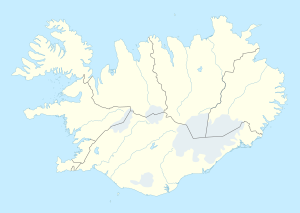Hvítá bridge
Coordinates: 64 ° 36 '12 " N , 21 ° 42' 33" W.
| Hvítá bridge | ||
|---|---|---|
| Hvítá Bridge 2008 | ||
| use | Street 510 | |
| Crossing of | Hvítá | |
| place | Borgarbyggð | |
| construction | Arch bridge | |
| overall length | 106 m | |
| width | 3 m | |
| Number of openings | 2 | |
| Longest span | 51 m | |
| Load capacity | 400 kg / m 2 , 6 t / vehicle | |
| building-costs | around 169,000 Icelandic kronor | |
| start of building | April 1928 | |
| opening | November 1, 1928 | |
| construction time | 6.5 months | |
| planner | Árni Pálsson | |
| location | ||
|
|
||
The Hvítá Bridge ( Isl . : Hvítárbrú , unofficial name) is a single-lane road bridge opened in 1928 over the Hvítá River in West Iceland. It is a 106 meter long reinforced concrete bridge consisting of two arches. Until the opening of the bridge over the Borgarfjörður near Borgarnes in 1981, the bridge was part of the main road connection between North and South Iceland. In 2002 it was recognized as the most outstanding Icelandic construction project of the decade 1921–1930 at an anniversary conference of the Icelandic engineering association Verkfræðingafélag Islands .
location
The bridge is located at the Ferjukot farm about four kilometers above the mouth of the Hvítá in the Borgarfjörður in what is now the municipality of Borgarbyggð .
construction
The bridge was designed by the Icelandic engineer Árni Pálsson (1897–1970). As was customary for Icelandic road bridges at the time, it was built in a single lane. The total length is 106 meters, the width 3 meters and the span of each arch is 51 meters. When construction began in April 1928, 1100 cubic meters of concrete and 22 tons of steel were used. The bridge is designed for vehicles with a maximum weight of 6 tons. The planned construction costs of 169,000 kroner could approximately be kept. Despite the cold and snow showers, around 500 people turned up for the inauguration ceremony on November 1, 1928 with Prime Minister Tryggvi hallórhallsson .
Web links
Individual evidence
- ↑ Útnefndu helstu verkfræðiafrek síðustu aldar , Morgunblaðið , article from April 20, 2002

